Yoga for fatigue
Yoga is a technique dating back thousands of years, its philosophical principles and techniques are based on creating harmony between mind, body and spirit. Regularly practicing yoga asanas or poses relaxes the body while at the same time revitalizes the lack of energy which causes you to be tired.
+ Tiredness is a symptom of an imbalance of strength and energy that yoga can help to put back into harmony. While many asanas require your body to work hard, over time you will benefit from yoga's relaxing effects: correct breathing, improved oxygen flow in the body, increased energy and better blood circulation.
It's best to practice yoga for 20 minutes, on a padded mat, in the morning before starting your day or in the evening at the end of your day.
It's also advised to begin these exercises with an instructor who can help to familiarize you with the techniques.
GENTLE EXERCISE
Yoga is a discipline designed to improve your flexibility and harmony. The exercises use gentle movements without straining your body. When practicing the asanas remember not to strain yourself. There is no need to push yourself too far. Remember to use gentle movements and don't push your body into a pose. Throughout time and willpower, you will improve your body's health naturally and get in tune with your body. It is important to remember to use your body with moderation, patience and consistency to prevent side effects like sore muscles or tiredness.
GETTING PREPARED
As with all exercises, before practicing yoga postures or asanas, you should prepare your body through a series of stretching exercises to warm up your muscles and to release tension.
Rocking chair
This pose is good for loosening and toning your muscles. It is used as a series of movements practiced at the beginning of a yoga session, although it is also good to practice this pose at the end of a session, before meditation. As the name suggests, this asana rocks the body, while at the same time increasing your muscle flexibility, releasing tensions, energizing and improving the flow of energy in the spinal cord. It's best to use a moderate rhythm, inhaling through the nose when you move backward and exhaling through the mouth when you move forward.
1. Sit on the floor, with your chin pressed against your chest. Bend your legs, with your feet pressed against the floor. Place your hands behind your knees, with your thumbs pointed outward. Keep your chin pressed to your chest to prevent back injuries.
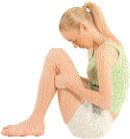
2. Lift up your feet, supporting them with your arms. Inhale and bring the body backward, maintaining the position of your legs and chin. Rock back and forth five or six times, keeping the legs bent to get the body ready.

3. Once the body has enough elasticity, use the motion to bring the torso backward and to stretch back your legs behind your head. If you can, try to touch the floor with the tips of your toes. Exhale and rock forward, without lifting up your chin. Repeat seven or eight times without stopping. Next, lie back down for a minute or two to relax your body.
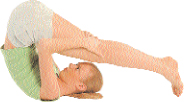
BREATHING FOR RELAXATION
Breathing is the body's most important function, which provides the primary element that our bodies need: oxygen. Yoga uses a number of techniques that concentrate on breathing, making yoga ideal for oxygenating, revitalizing and fighting against tiredness.
Nasal breathing –naturally practiced since birth– carries a connection to the cosmic Universe's rhythm. As we grow up and our natural biological processes accelerate, our synchronism with the Universe alters, giving way to a daily vertigo. When we breathe through our mouths, we absorb more air in less time, but without filling our lungs. Also, when we exhale we don't expel all the carbon dioxide from our lungs.
COSMIC BREATHING
Even though breathing is an instinctive biological function, we tend to breathe incorrectly. The most natural canal for the breath is the nose:
- • The tiny hairs inside the nostril filter and purify the air.
- • The air is warmed by contact with the veins inside the nostrils.
- • It relaxes the nervous system.
- • It purifies the body by expelling carbon dioxide.
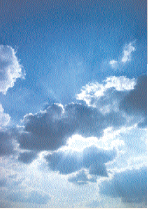
BREATHING TO RELAX
We have put together a list of exercises that will help you to breathe consciously, to energize you and to revitalize your body, especially when you are tired. However, you should take note that sometimes these exercises can make you dizzy. If this happens, it's best to take a break from the exercises and practice them later with less intensity.
∎ Abdominal and Diaphragmatic Breathing
Diaphragmatic breathing uses the diaphragm, a muscle located under our ribs and above our stomach. When we breathe in, we push the muscle down and our stomach moves forward. When we breathe out, the diaphragm moves back to resting position and the abdomen moves back in. It's best to do this breathing technique lying down, on the floor or on a padded mat.

1. Take a deep breath, inhaling slowly through your nose and expanding your abdomen. Concentrate on your energy in that spot.

2. Slowly exhale, contracting your abdomen before taking another breath. While exhaling, when the air passes through the throat make a sound as if you were snoring. Repeat 4 or 5 complete breaths.
∎ Alternate breathing
This exercise consists of inhaling and exhaling through the nostrils alternately. Use your right hand, place your index and middle fingers below your eyebrow and use your thumb to close one nostril at a time, alternating between the right and left nostril.
1. Sit with your back straight and your head slightly tilted downward. Begin to exhale through your left nostril, while you close your right nostril with your thumb. Inhale through the same nostril.

2. Close your left nostril with your ring finger and exhale through your right nostril. Inhale through your right nostril; close the right nostril with your thumb and exhale through the left nostril. You should always begin and end a breathing cycle with the left nostril. Complete 3 or 4 breathing cycles.

POSTURES TO RELIEVE YOUR TENSION
When you are suffering from tiredness, nothing is better to energize the body than yoga. Asanas also bring a total state of relaxation.
The Seated forward bend
This asana uses slow movements, and is an ideal exercise for moments when you feel exhausted. It brings vitality, literally stretches the back part of the body, at the same time stretches the vertebrae and stimulates blood flow of the back. This pose clears your mind and calms the spirit.
1. Begin by sitting, with your legs together and stretched forward. Keep you back straight and your arms on the sides of your body, supported by your palms. Your body should form a 90 degree angle. Take in a deep breath through the nose and stretch your arms above your head as high as you can, stretching the spine. Do not arch the back.

2. As you exhale bring your chest toward your thighs. Bring your hands to your feet and, if you can, wrap your fingers around them. Breathe comfortably, while you exhale lowering your torso as far as you can. It's ideal to bring your abdomen to your thighs. The idea is to continue right down and hold on to whichever part of your legs or feet you can comfortably reach. You can also place a cord behind your feet and grab onto it instead of your toes.

Reverse pose
This exercise helps the body to recuperate, to clear and calm an exhausted mind and to relieve headaches. It also helps to improve blood circulation especially for the blood flow to the brain.
Begin by lying down with the palms of your hands on the floor, your legs together and looking forward. Lift up your legs and then your torso. Support your waist with your hands, so that your legs and torso are at an angle. Your feet should be raised directly above your head. Stay in this position for as long as you feel comfortable, breathing slowly. Next, slowly lower the legs and relax your body for a few moments.
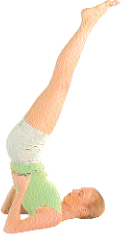
Relaxing pose
Although this is a passive pose, this asana is beneficial for its ability to relieve tensions and energize the body. Dedicating 10 minutes to this asana is equivalent to two hours of deep sleep because of its capacity to recover mental and physical vital energy.

Lie on your back looking for the most comfortable position for your body: shoulders relaxed, back straight, loose hips and legs slightly apart. The tips of your toes should face outward; your arms, a bit separated from the body, with the palms of your hands open and facing upward. Close your eyes, breathing slowly and deeply. Concentrate on tensing and relaxing each muscle, from your toes to your head. You will feel the weight of your body. Stay in this position for a few minutes, with your eyes closed and without breathing deeply. You will rest significantly in a brief amount of time.
MUDRAS FOR FATIGUE
This technique, dating back thousands of years, uses mudras or physical gestures considered sacred for their energetic power to relieve tiredness. Practicing mudras is easy and doesn't require a professional practitioner or instructor.
There are four mudras or gestures to treat problems of fatigue. You may practice these gestures three times a day for 15 minutes. You can practice mudras in any place (except for the dawn mudra ). Over time and with constant practice you will recuperate lost energy.
∎ Dawn mudra
1. In the morning, before getting out of bed, clasp your fingers so that your right thumb sits on your left thumb and gently press.
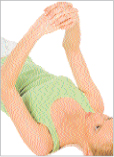
2. Next, bring your hands behind your head and breathe deeply several times, while you open your eyes and mouth. Press your elbows backward against your pillow. You will feel a wave of energy that will help you face the day with more strength.
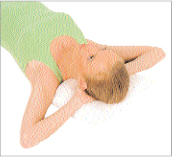
∎ Earth mudra
With your palms facing upward, place the point of your thumbs at the base of your ring fingers. Apply gentle pressure while the rest of the fingers are stretched out. Repeat with both hands. The ring finger symbolizes the earth element, which is stimulated to recuperate strength and physical and mental stamina. You can practice this mudra in the Lotus position or any other position or place.

∎ Sky mudra
With your palms facing upward and your thumbs and middle fingers pressed together. Keep the rest of your fingers extended. Practice this mudra with both hands. This gesture stimulates optimism and a good mood. As with the earth mudra, it can be practiced in the Lotus or any other position, without necessarily being an asana.
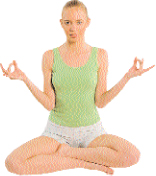
∎ Purifying mudra
With the palm of your left hand facing upward with your thumb, middle, ring and pinkie finger pressed together. Your index finger should be extended, as if you were pointing to something. Repeat on your right hand but this time press your thumb, index, middle and ring fingers together and point with your pinkie. This mudra detoxifies your body and mind. This mudra can be practiced in the Lotus position or any other position.
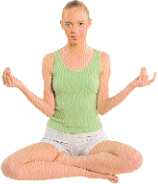

Comment about this article, ask questions, or add new information about this topic: